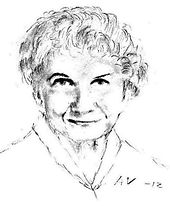stories
Stories (original Fiction , 2007/2009) is a short story by Alice Munro, which describes, among other things, how a reader enters into dialogue with what has been read. The interplay of life and art is thematized in a way that is characteristic of Munro: with a complex structure that sometimes remains vague in terms of time.

action
Joyce works as a music teacher at the beginning of the story and experiences several partner changes in her environment during the course of the story. Joyce herself is in her second marriage when she becomes interested in a young author who appears at her husband's sixty-fifth party and whom she recognizes on a poster shortly afterwards. In one of her short stories, too, Joyce believes she recognizes something from the past: “finding a version of herself presented in someone else's fiction”, it says in a review. She then goes to a book signing and experiences something she thinks - after she has regained her composure - that she might one day tell it as a strange-funny story.
Interpretations
In his review in September 2009, James Grainger said this work is masterly at drawing the reader's sympathy to this and to that person. Minor characters are introduced in order to shock the manipulatively inclined main character by saying that they are not in their role plan to be fitted. This story is perhaps the best in the collection. Grainger gives the title of the story in the plural. Todd VanDerWerff also considers fiction to be the highlight of the collection, on the one hand on a technical level and on the other hand because Munro knows how to fill every sentence with the emotions inherent in the story. In this work techniques are used that are characteristic of the author: memory as a catalyst, a narration in which one jumps back and forth between past and present, figures who quietly make discoveries for themselves that shake their center, and all of this is thematically linked to the unbending end of a marriage. The story is told from at least four angles, but without leaving the main character's perspective. Fiction , says literary scholar Ailsa Cox, is a good example of how Munro works with tension between continuity and interruption. Structurally, both chapters of the story are built up as a montage of elliptical passages. With a change of tense from the past tense to the present tense, the second part changes the pace of the narrative and brings about a change of location. The first third of the story now appears as a memory and no longer as an experience that is still going on. In addition to a series of other narrative shocks, the reader, according to Cox, also has to reorient himself on this point, because what appeared in the first part as the present seems to have already passed while reading. When the first husband comes up, he is introduced like a new character, as if a new story had started.
Editions and versions
Fiction was first published in Harper's Magazine in August 2007 and is later included in Alice Munro's thirteenth collection of short stories, Too Much Happiness (2009), which was published in German under the title Too Much Happiness (2011). The story in Too Much Happiness in English is about 30 pages long.
In the 2007 magazine version, the short story writer is Margaret (Maggy) and not Christine (Christie), and the third wife of Joyce's ex-husband is not Christine, but Charlene. Instead of the fifteen sections of the first version, the second version has been shortened by three section changes to twelve sections and is shorter overall. The magazine version consists of three parts, the book version has been reduced to two parts. Part II begins with the second stage of Joyce's life and begins at the party for her second husband's 65th birthday. The 2009 version has fewer adjectives. The narrator uses comments more sparingly in this later version and many of the references to the situation in the first part of the story are no longer included in the later version.
Research literature
- Ailsa Cox, “Age could be her Ally: Late Style in Alice Munro's To Much Happiness ”, in: Alice Munro , edited by Charles E. May, Salem Press, Ipswich, Massachusetts 2013, ISBN 978-1-4298-3722 -4 (hardcover), ISBN 978-1-4298-3770-5 (ebook) table of contents , pp. 276–290, therein on fiction pp. 279–281.
See also
Individual evidence
- ↑ a b Ailsa Cox, “Age could be her Ally: Late Style in Alice Munro's To Much Happiness ”, in: Alice Munro , edited by Charles E. May, Salem Press, Ipswich, Massachusetts 2013, pp. 279–281 .
- ↑ Alex Ramon: "Too Much Happiness", in: British Journal of Canadian Studies (23: 2) 2010, 313-314
- ↑ James Grainger, Too Much Happiness by Alice Munro , Quill & Quire , September 2009, last accessed December 7, 2013.
- ↑ Todd VanDerWerff, Alice Munro: Too Much Happiness , avclub.com Book review, December 17, 2009, last accessed December 7, 2013.
